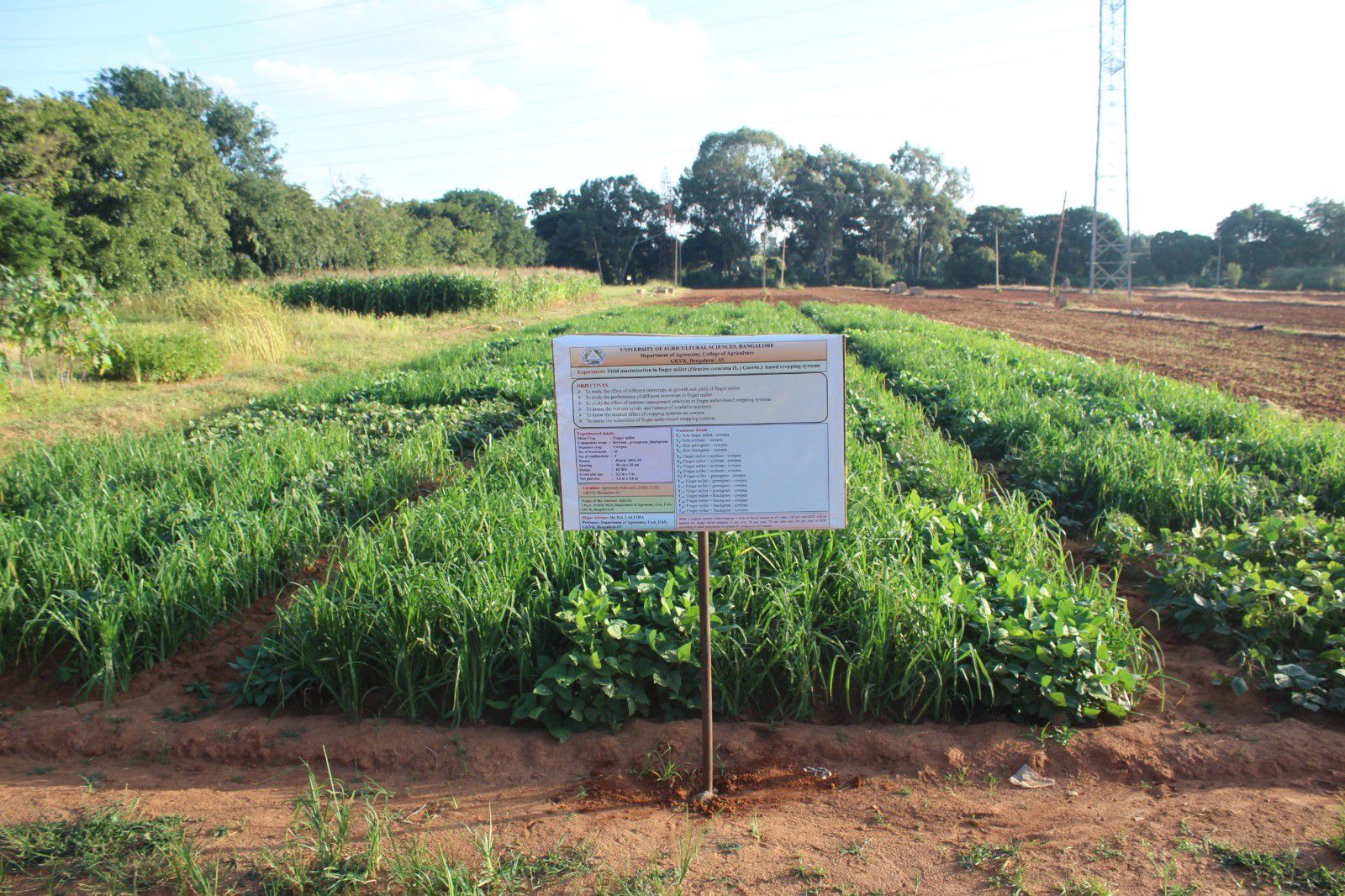- 1University of Agricultural Sciences, GKVK, Bengaluru, Karnataka, India
- 2ICAR-National Institute of Seed Science and Technology, Regional Station, Bengaluru, Karnataka, India
- 3ICAR-National Bureau of Soil Survey and Land Use Planning, Regional Centre, Bangalore, India
- 4University of Agricultural Sciences, Raichur, Karnataka, India
Indian agriculture is confronted with a multitude of sustainability challenges, including the impacts of climate change, inefficiencies in input usage, depletion of natural resources, soil degradation, excessive energy consumption, and various environmental concerns viz., burning of the crop residues. Tackling these challenges necessitates integrated strategies that foster climate-resilient farming, optimize resource utilization, and encourage the adoption of sustainable agricultural practices. To address these issues, a field study was conducted focusing on millet + legume combination, wherein soybean, green gram and black gram were intercropped with finger millet, and cowpea was grown as sequence crop. The Randomized Complete Block Design with Factorial concept with three replications was employed to assess the effectiveness of different finger millet-based legume intercropping systems and varied levels of recommended doses of fertilizers (RDF) to intercrops. The findings revealed that, among the different intercropping systems, the combination of finger millet + green gram recorded significantly higher (p=0.05) grain (2513.10 kg/ha) and straw (7526.19 kg/ha) yield of finger millet The same intercropping system yielded significantly (p=0.05) higher seed (899.40 kg/ha) and haulm yield (2295.12 kg/ha) of green gram compared to other intercrops. Among the nutrient management approaches, applying 75% RDF to the component crops resulted in the highest grain/seed yield (2688.98 kg/ha for finger millet and 932.46 kg/ha for green gram) and straw/haulm yield (7850.88 kg/ha for finger millet and 2122.74 kg/ha for green gram). The residual impact of the finger millet-based intercropping system on a subsequent cowpea crop led to a notable increase in its seed yield (1599.66 kg/ha) and haulm yield (3445 kg/ha) under finger millet + soybean intercropping system, where 75% RDF was supplied to soybean. Additionally, productivity metrics such as finger millet equivalent yield (FMEY), land-equivalent ratio (LER), competition ratio (CR), and area-time equivalent ratio (ATER) were maximized in the finger millet + green gram intercropping system. These findings underscore that the combination of green gram with finger millet, along with the application of 75% RDF, significantly (p=0.05) boosts the overall productivity of the intercropping system.
Introduction
India is the most populous nation, experiencing a year-on-year increase in its population. The Food and Agriculture Organization (FAO) states that, global food production must rise by 70% by 2050 to satisfy the needs of an anticipated population of 9.7 billion (Falcon et al., 2022). Modern input-intensive monoculture systems have greatly boosted food production and aided in achieving self-sufficiency (Belete and Yadete, 2023). Nevertheless, the heavy dependency on synthetic fertilizers and pesticides has led to adverse effects, such as the degradation of soil health (Dong et al., 2024), depletion of groundwater, increased pests and diseases incidence, and various environmental problems like eutrophication (Kumar et al., 2022, 2025), greenhouse gas (GHG) emissions, and loss of biodiversity (Mrabet, 2023; Ahmed et al., 2022). These issues, exacerbated by increasing climate vulnerability, present a serious threat to agricultural sustainability (Rajanna et al., 2023). Therefore, there is an immediate necessity to develop/adopt sustainable farming practices that not only amplify food production but also ensure environmental safety (Akchaya et al., 2025). These novel technologies/practices include plenty of agronomic practices viz., choice of suitable crops or cropping systems, irrigation and nutrient management, pest and disease control, etc. Further, under fluctuating climatic conditions over the years, stimulating the farming community towards combining the various components rather than relying solely on single crop enterprise is gaining wider importance. The crops chosen for integrated cultivation, must possess high plasticity, aid in ecosystem restoration and should satisfy nutritional security in order to achieve sustainability in the farming sector.
In the recent past, millets are gaining greater importance in agricultural production systems. This is due to their widely adoptive nature and least input demand compared to other cereals coupled with nutri-richness ensuring agricultural sustainability and nation’s nutritional security (Gupta et al., 2022; Sukanya et al., 2023). Among the number of millets being cultivated in India, finger millet occupies largest area due to its own preferential features (Sannagoudar and Murthy, 2018). Statistically, finger millet occupies 1.16 million hectares with an average yield of 1454 kilograms per hectare (Anonymous, 2023). This wider area under cultivation of finger millet is due to its ability to thrive in various agro-climatic environments, which enhances its reputation as the most productive crop among the millet varieties (Gopalan et al., 2002). The Karnataka, Tamil Nadu, Andhra Pradesh, and certain areas of North India owes major area under cultivation of finger millet in India (Vijayakumari et al., 2003). Besides wider agronomic adoptability, finger millet serves as a valuable source of vital nutrients, especially calcium, dietary fiber, and several other minerals (Gull et al., 2014). In-spite of its several advantages, finger millet production is taking a dip due to severe competition from major cereals and other commercial crops. Further, the productivity of finger millet in Indian scenario still remains far from its actual potentiality due to inefficient and unscientific agronomic management practices being followed since ages (Sukanya et al., 2024).
Legumes are the next best viable crop option for the dryland farms. Due to their innate capacity to withstand climatic aberrations their demand for production inputs remains much abbreviated than the major crops (Halli et al., 2021). Further, they play vital role in restoring soil health through erosion control, atmospheric nitrogen fixation capacity, increase water infiltration through their tap root system, add huge quantity of organic biomass through leaf shedding, etc (Sannagoudar et al., 2021). Alongside, legumes also contribute to nutritional security as they form rich source of protein and many other mineral nutrients. Their post-harvest residue serves as highly palatable dry form of fodder, ensuring year-round feed supply for the dryland livestock.
Over the years, increased demand for food, nutritional security, climatic aberrations are questioning the present agricultural practices for their sustainability. The answer to this question was crop diversification rather than monocropping (Sannagoudar et al., 2024). Though, crop diversification encompasses ample of options, the agro-climatic conditions of dryland impose greater limitations for crop selection. Hence, the most probable crop selection would be millets intercropping with legumes. Possessing differential growth habits, nutritional composition, and least input demand of both the crops makes them a best combo of intercropping system for the semi-arid conditions of Indian peninsula. This millet + legume combo of intercropping system offers many advantages viz., efficient utilization of natural resources (Sukanya et al., 2024), reduced dependency on synthetic fertilizers (Chavan et al., 2017), enhanced productivity (Jan et al., 2016) and biodiversity (Maitra and Ray, 2019), soil health rejuvenation (Gupta et al., 2020), assured harvest even under aberrant climatic conditions and economic stability for the dryland farmers (Singh et al., 2016). Further, the tap roots of legume crops proved to aid in bio-irrigation for millet crops (Mohan Kumar et al., 2022). Further, millet-based legume intercropping system promotes beneficial soil micro flora besides suppressing pest and disease-causing organisms (Chamkhi et al., 2022).
Despite owing ample advantages, millet-based legume intercropping system are least adopted in the famers’ field. This is due to lack of knowledge on various aspects of its adoption. Firstly, any recommended intercropping system or crop choice is site-specific, which needs spatio-temporal rectifications. Secondly, in intercropping system, agronomic management is only limited to base crop while, component crop enjoys the least management leading to reduced overall productivity. Thirdly, the effectiveness of any intercropping was assessed only based on the productivity of component crops, but the literature pertaining to residual effect of different intercropping systems on succeeding crop is very meagre till date. Fourthly, the fact that even intercropped legumes demand external nutrients supply which help in boosting the overall system productivity has been much neglected. Sannagoudar and Murthy (2018) and Shekara et al. (2025) opined that, an integrated nutrient management focusing both the component crops is vital in boosting the total intercropping system productivity. Thus, keeping these research gaps in mind, an experiment was conducted to provide comprehensive and scientific assessment of millet-based legume intercropping against various productivity metrics. Further, the present study also aimed to assess the residual effect of different intercropping combinations coupled with varied nutrient management practices on the sequential crop. Thus, the scientific understanding on these aspects will certainly promote crop diversification with suitable crop combination and ideal nutrient management strategies to attain maximum productivity under semi-arid Indian peninsular region. Also, the study also gives scientific evidence regarding necessity of nutrient supply to the component crops in boosting the total system productivity. Further, the residual effect of different intercropping systems coupled with optimized nutrient management strategies validate the feasibility of growing succeeding crop under resource scarce areas of dryland. The findings from the present investigation will certainly aid in devising practically suitable crop diversification strategies in order to achieve yield sustainability, environmental viability and economic stability for the marginal farmers residing across Indian semi-arid tropics region.
Materials and methods
Experimental site description
The experiment was carried out during 2024 at the Zonal Agricultural Research Station (ZARS), Gandhi Krishi Vignana Kendra, University of Agricultural Sciences, Bangalore which falls under Eastern Dry Zone (ACZ-V) of Karnataka. This is situated at an elevation of 924 meters above mean sea level and at a latitude of 13° 07’ N and longitude of 77° 57’ E. The soil at the experimental site was red sandy loam falling under the Alfisol soil order. Composite soil samples were randomly collected from the top 0-15 cm layer prior to experimentation and were subjected to analysis for their physico-chemical properties following the standard procedures. For determining pH and electrical conductivity of the soil, soil:water (1:2.5) suspension was made and readings were recorded in pH meter for pH and conductivity meter for electrical conductivity (dS/m) estimation (Jackson, 1973). Organic carbon was estimated by Walkley and Black’s wet oxidation method. In this method, a known weight of soil was oxidized using known excess volume of 1 N potassium dichromate (K2Cr2O7) solution in the presence of concentrated H2SO4. The excess K2Cr2O7 which was not reduced by organic matter of soil was determined by titrating it with standard ferrous ammonium sulphate solution in the presence of ferroin indicator and expressed as %. The available nitrogen in soil was determined by alkaline potassium permanganate distillation method as described by Subbiah and Asija (1956). The available phosphorus in soil was extracted using brays reagent as the studied soil is acidic in pH. The extracted phosphorus was then estimated by ascorbic acid blue color method. The intensity of blue color was read in a spectrophotometer (T70 UV/VIS Spectrometer) at a wavelength of 660 nm (Jackson, 1973). Available potassium in the soil was extracted using neutral normal ammonium acetate (NH4OAc) and the potassium content in the extractant was estimated using flame photometer (Systronics flame photometer 128) (Jackson, 1973). The results showed revealed that, soil was slightly acidic in pH (5.8), low in organic carbon (0.49%) and low in electrical conductivity (0.30 dS/m). The initial soil nutrient status was medium for available nitrogen (304.84 kg/ha), phosphorus (P2O5) (29.67 kg/ha) and potassium (248.71 kg/ha). The experimental site depicts a typic semi-arid conditions of Indian peninsular region where agriculture production depends largely on rainfall. The Figure 1 depicts the key weather conditions prevailing during the experimentation period. A total of 1436 mm rainfall was received during the cropping season. while the mean maximum and minimum temperature and relative humidity were recorded in the range of 54-84%. In general key weather parameters recorded during the experimentation period were congenial for successful crop production and experiment execution.
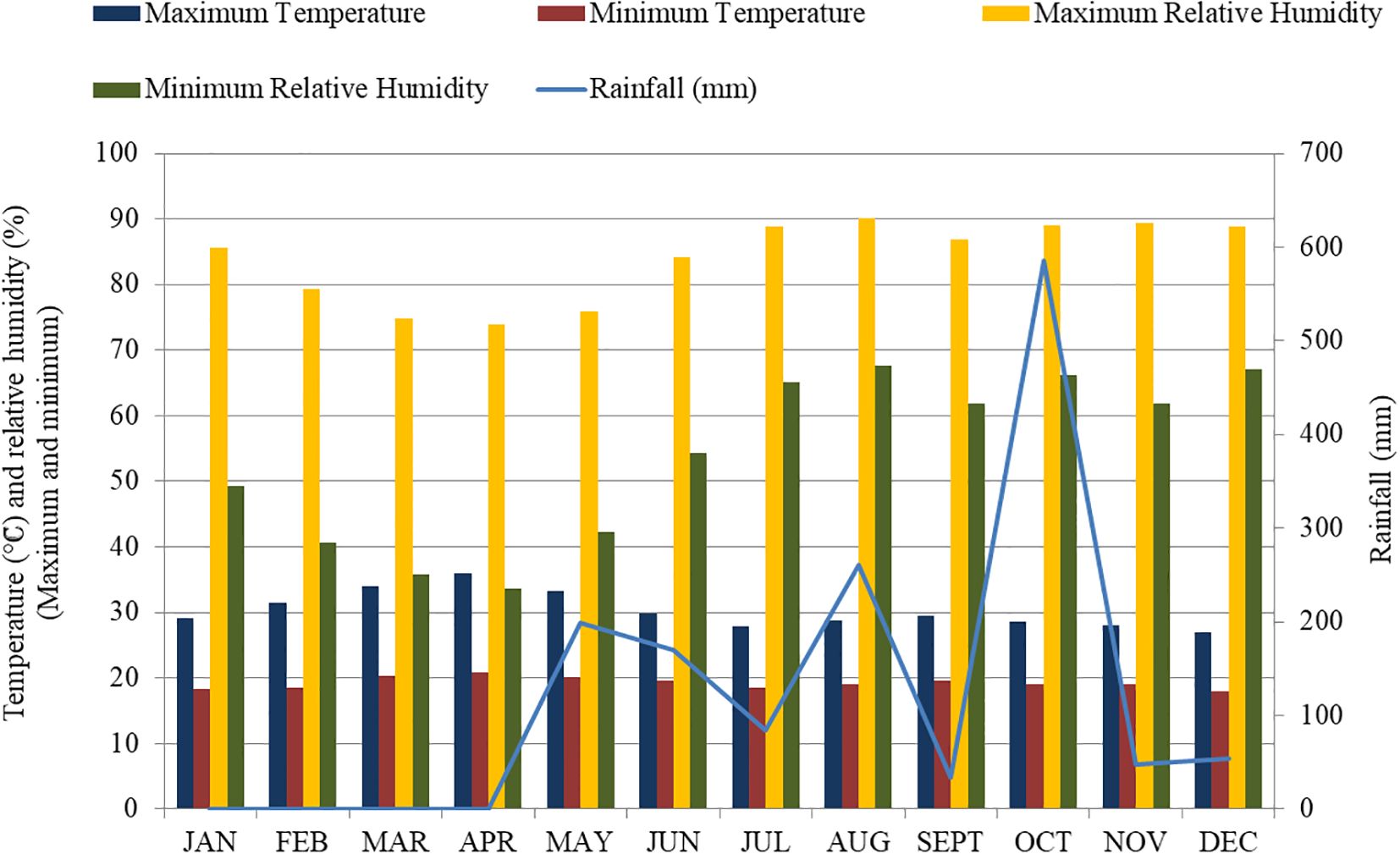
Figure 1. Monthly meteorological data prevailed during the experimental period (2024) at GKVK, Bengaluru.
Experimental details
Experimental design and treatment details
The experiment was assessed in two employing separate designs for the evaluation of intercropping systems and for assessing the residual effect on succeeding crop. The Randomized Complete Block Design (RCBD) with Factorial concept with three replications was employed for assessing Finger millet-based legume intercropping systems during Kharif 2024. This consists of two factors viz., Factor A: Intercrops (I) [I1 – Finger millet + soybean; I2- Finger millet + green gram; I3- Finger millet + black gram] and Factor B: Nutrient management (N) [N1- Control; N2- 50% RDF; N3-75% RDF; N4-100% RDF *Note: These varied nutrient levels were applied to only intercrops based on their row proportion under intercropping system, while recommended package of practices was followed for base crop (finger millet). RDF- Finger millet: 100:50:50 (N:P2O5:K2O Kg/ha), Soybean: 30:80:37.5 (N:P2O5:K2O Kg/ha), Green gram: 25:50:50 (N:P2O5:K2O Kg/ha) and Black gram: 25:50:50 (N:P2O5:K2O Kg/ha)]. Post-harvest of these intercrops, cowpea was grown employing simple RCBD to assess the residual effect of different intercropping systems during Rabi 2024. In this experiment finger millet is grown as a base crop in finger millet based cropping system and cowpea as a sequence crop. The pure crops of the respective base crops and intercrops were raised separately for computation of cropping system indices. The general view of experimental plot and best treatments are illustrated in Figures 2 and 3.
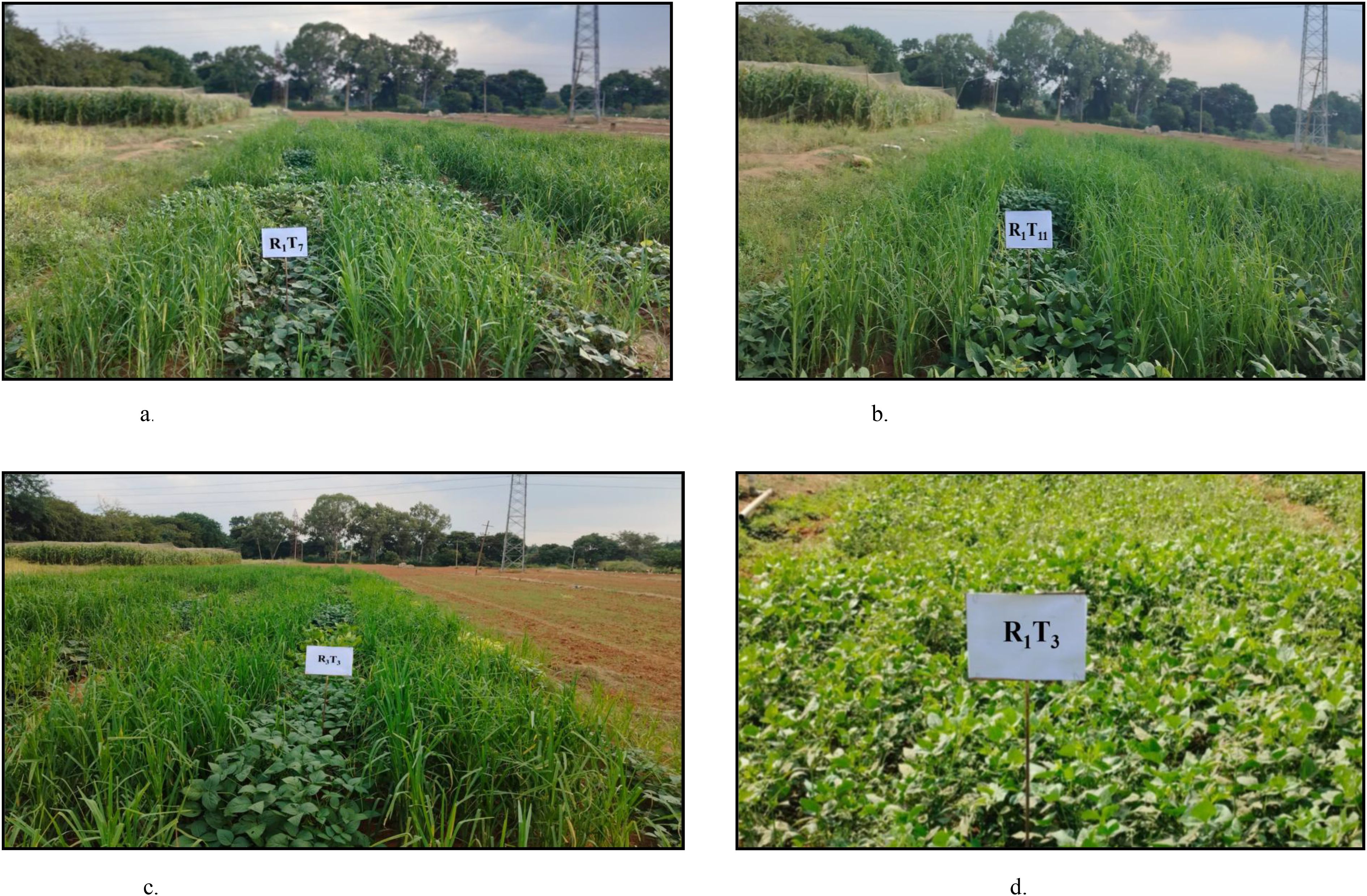
Figure 3. (a–d) The best treatments of the experiment. (a) Finger millet + green gram (75% RDF) (b) Finger millet + black gram (75% RDF) (c) Finger millet + soybean (75% RDF) (d) cowpea.
Experimental layout and crop husbandry practices
The experimental area was divided into 12 plots (treatment combinations) replicated thrice with a dimension of 4.2 m × 3 m. Each plot was separated by a rised bund for clear differentiation between the plots. The seed rows each at 30 cm apart were opened manually with the help of pickaxe so as to adjust the intercrops in 4:2 row proportion (spacing followed was 30 cm × 10 cm for all the crops). Pictorial view of the experiment depicting different intercropping systems is shown in Figure 4. The seeds were procured from National seed project, GKVK, Bengaluru and the varieties used for sowing were GPU-28 (finger millet), KBS-23 (soybean), KKM-3 (green gram), LBG-791 (black gram) and KBC-12 (cowpea). The farmyard manure was incorporated two weeks prior to sowing. The fertilizers were applied to each plot as per the treatments. The sources of nitrogen, phosphorous and potassium used were urea, single super phosphate, and muriate of potash, respectively. The full dose of P&K recommended for finger millet and full dose RDF of intercrops (as per treatments) was applied at the time of sowing as basal/starter dose, while 75% of recommended nitrogen to finger millet was applied at sowing followed by top dressing of remaining 25% at 21 DAS (Days After Sowing). Following crop establishment, to ensure optimum plant density, gap filling was done at 15 DAS wherever poor plant stand was observed. Similarly, thinning was taken up at 20 DAS wherever excess population was noticed. To assess the weed smothering efficiency of intercropping system, weeding operation was not done throughout the cropping period to see the weed smothering efficiency by intercrops in finger millet based cropping system. The curative measures were taken against hairy caterpillars by spraying dimethoate at 2 ml per liter of water for component crops and spraying of saaf (Carbendazim+ Mancozeb) at 1 g per liter of water against powdery mildew and anthracnose in green gram and black gram. Harvesting was done manually using sickles ensuring the crop attained physiological maturity. After the harvest of all the intercrops, seed furrows were opened manually with the help of pickaxe to sow the cowpea as sequential crop without disturbing experimental plots. For, cowpea recommended package of practices formulated by University of Agricultural Sciences, Bangalore was adopted commonly to all the treatments.
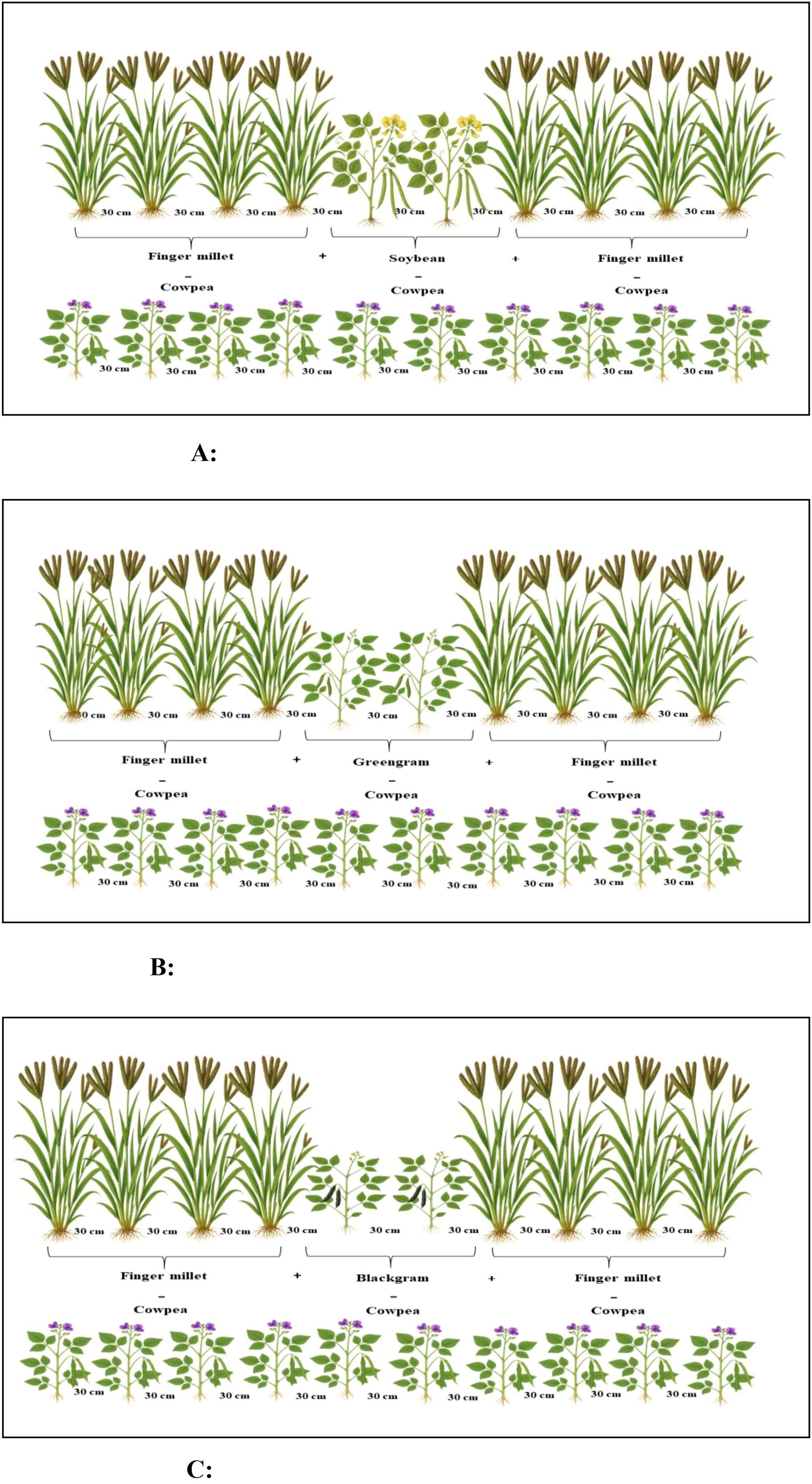
Figure 4. (A–C) Illustration of row proportions of crops in finger millet based cropping system. (A) Finger millet + soybean (4:2) - cowpea (B) Finger millet + green gram (4:2) - cowpea (C) Finger millet + black gram (4:2) - cowpea.
Experimental data collection
Five plants from the net plot were randomly selected and tagged for recording growth and yield attributes in each plot. These parameters were measured at 90 days after sowing (DAS) for finger millet and at harvest for intercrops and the sequence crop, respectively. The tagged plants in the net plot area were used for recording biometric observations, while plants in the border rows were used for recording dry matter observation on periodic basis. The plants in the net plot area were harvested, sun dried and subjected for threshing separately for recording yield data treatment wise. The composite soil samples were collected from a depth of 0 to 15 cm from each plot post-harvest of the crops for analyzing soil nutrient status. The standard procedures mentioned earlier in the ‘materials and methods’ section were employed for analyzing the soil nutrient status.
For assessing the efficacy of intercropping systems and for assessing their residual effect on succeeding crop the various metrices used are detailed below.
Absolute growth rate
The formula developed by West et al. (1920) was used to determine AGR (Equation 1).
Where,
W1- Plant dry weight at time t1
W2;– Plant dry weight at time t2
Crop growth rate
CGR was calculated according to the formula by Radford (1967) (Equation 2).
Where, W1 and W2 represent the amount of dry matter produced by each plant in grams at times t1 and t2, respectively.
P = Spacing
Light transmission ratio
A Lux meter was used to measure the amount of light that was transmitted through the canopies of sole maize, sole intercrops, and intercropping systems. Between 12:30 and 1:00 pm, measurements of the light intensity at ground level (I) and above canopy (I0) were made. The system’s LTR was then averaged using row proportions. The following formula (Equation 3) was used to get the light transmission ratio (Yoshida et al., 1972).
Where, I = Light intensity received at the ground level
I0 = Light intensity received at the top of crop canopy
Light absorption ratio
It was calculated by the following formula (Equation 4).
Land equivalent ratio
Land equivalent ratio is defined as the relative land area under sole crop that is required to produce yields achieved in intercropping. LER was worked out by using the following formula (Equation 5) given by Willey (1979).
Where,
Yab and Yba = Individual crop yield under intercropping
Yaa and Ybb = Individual crop yield under sole cropping
Area time equivalent ratio
ATER was calculated according to the formula (Equation 6) by Hiebsch and Macollam (1980).
Where,
LER = Relative yield of species a and b
t = Duration (days) for species a and b
T = Total duration (days) of the intercropping system
Competition ratio
Competition ratio is calculated by following formula (Equation 7),
Where,
Yaa - Yield of component crop a as sole crop
Ybb - Yield of component crop b as sole crop
Yab - Yield of component crop a as intercrop in combination with b
Yba - Yield of component crop b as intercrop in combination with a
Zab - Sown proportion of component a in combination with b
Zba - Sown proportion of component a in combination with b
Finger millet equivalent yield
The finger millet equivalent yield of intercropping system was calculated by taking into account the seed yield of component crops and the prevailing market price of the both maize and intercrops as follows (Equation 8).
Where,
Yb - Yield of intercrop (kg/ha)
Pb - Price of intercrop (Rs. kg-1)
Pa - Price of finger millet (Rs. kg-1)
Weed smothering efficiency
Weed smothering efficiency is calculated by following formula (Equation 9),
Statistical analysis
Data analysis and interpretation were carried out using Fisher’s analysis of variance (ANOVA) method, as outlined by Panse and Sukhatme (1967). The level of significance used in “F” and “t” test was p = 0.05. Critical difference values were calculated where ever the “F” test was found significant and multiple comparisons test was done by using “Duncan’s Multiple Range Test”.
Results and discussion
Effect of intercropping and nutrient management on growth and yield of finger millet
The growth trajectory of finger millet was markedly influenced by both intercropping arrangements and nutrient management strategies as presented in Table 1 and Table 2. Notably, the finger millet + green gram consistently outperformed other combinations, as evidenced by a significantly (p=0.05) higher tiller count (8.05 tillers/plant), dry matter accumulation (11.11 g/plant), AGR (0.218 g/day) and CGR (7.27 g/m/day). These metrics were statistically comparable to the finger millet + black gram system but substantially exceeded those observed under sole cropping or other intercrop treatments. Conversely, the highest LTR (50.05%) was recorded in finger millet + soybean, while finger millet + green gram showed superior LAR (55.91%) in finger millet under finger millet based cropping system because of enhanced vegetative performance in finger millet, attributed to increased functional complementarity and resource-use efficiency, particularly in terms of light interception, nutrient uptake and root-zone exploitation (Sachin et al., 2023; Dass et al., 2024) who emphasized the ecological advantage of legumes in enhancing system-level productivity through niche differentiation and biological nitrogen fixation. Moreover, intercropping with green gram appeared to exert minimal competitive pressure on finger millet, facilitating a more balanced resource partitioning consistent with the facilitative interspecific interactions (Choudhary et al., 2014; Sannagoudar et al., 2021). Nutrient management practices also exerted a significant effect on growth parameters of finger millet. Application of 75% RDF to the component crop was particularly beneficial, enhancing dry matter accumulation (11.29 g/plant), tiller production (7.90 tillers/plant), AGR (0.224 g/day), and CGR (7.45 g/m²/day). Interestingly, the highest LTR (50.07%) was observed in treatments receiving no RDF (control), suggesting a potential shift in assimilate allocation towards leaf thickness under nutrient stress. In contrast, the maximum LAR (57.33%) was associated with the 75% RDF treatment. These outcomes underscore the critical role of nutrient optimization in intercropping systems. The observed growth advantage under 75% RDF could be linked to improved nutrient uptake dynamics, stimulating meristematic activity, cell division and photosynthetic capacity mechanisms corroborated by previous studies (Hayat et al., 2010; Kaushik and Sharma, 2017; Patidar et al., 2023). The synergy between legume intercropping and moderated nutrient application likely created a microenvironment conducive to higher physiological efficiency and biomass accumulation. Despite the significant main effects, interaction effects between intercropping and nutrient treatments were statistically non-significant for all growth attributes. This suggests that, while both factors independently shape crop performance, their combined influence may not always be additive or synergistic. Taken together, the finger millet + green gram intercropping system, in conjunction with 75% RDF application to the component crop, emerged as the most robust strategy for enhancing early growth dynamics in finger millet. This integrated approach aligns well with the principles of sustainable intensification, offering a viable pathway to improve biomass productivity while reducing fertilizer input.
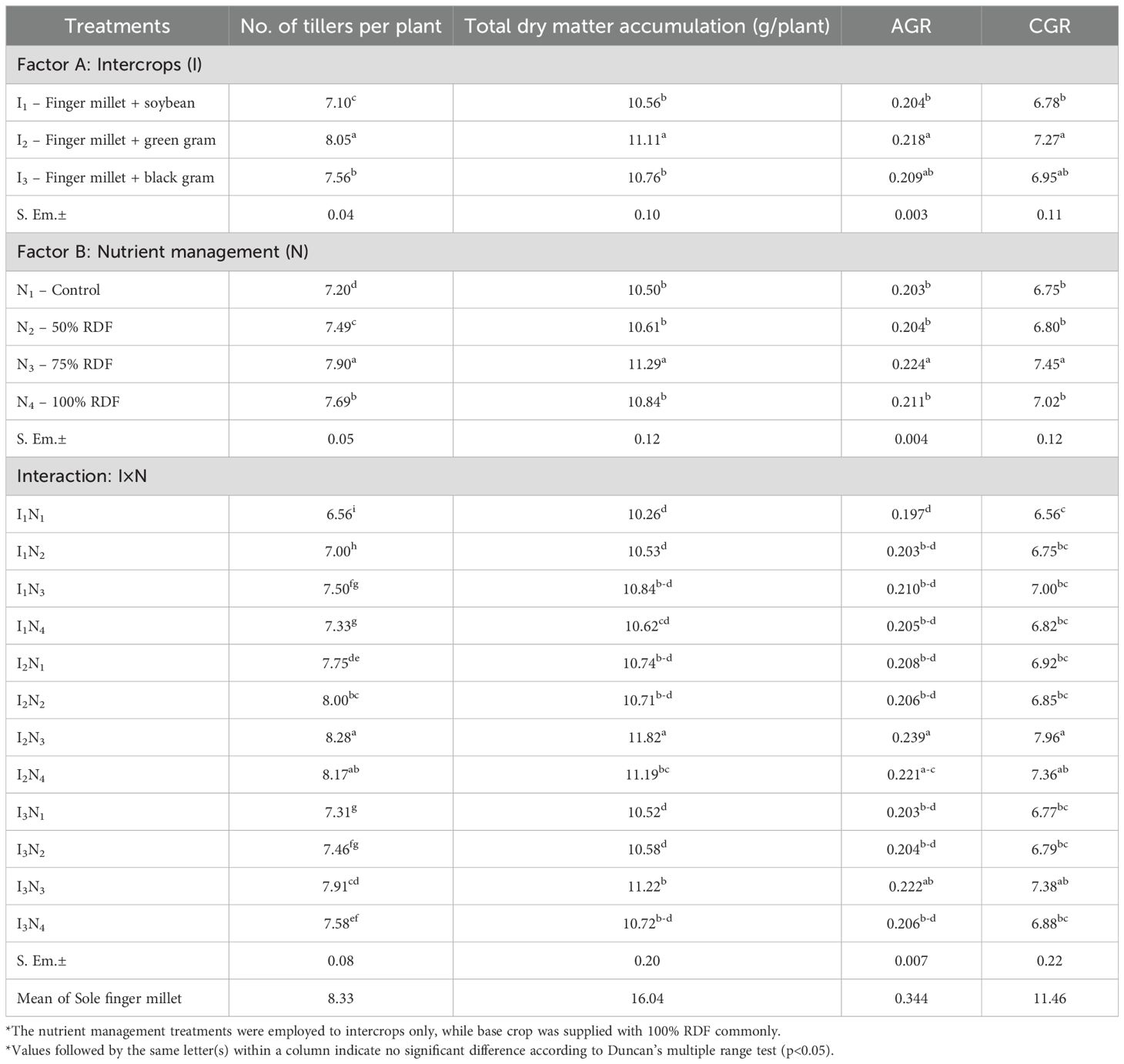
Table 1. Effect of intercropping and nutrient management on growth parameters of finger millet in finger millet based cropping system.
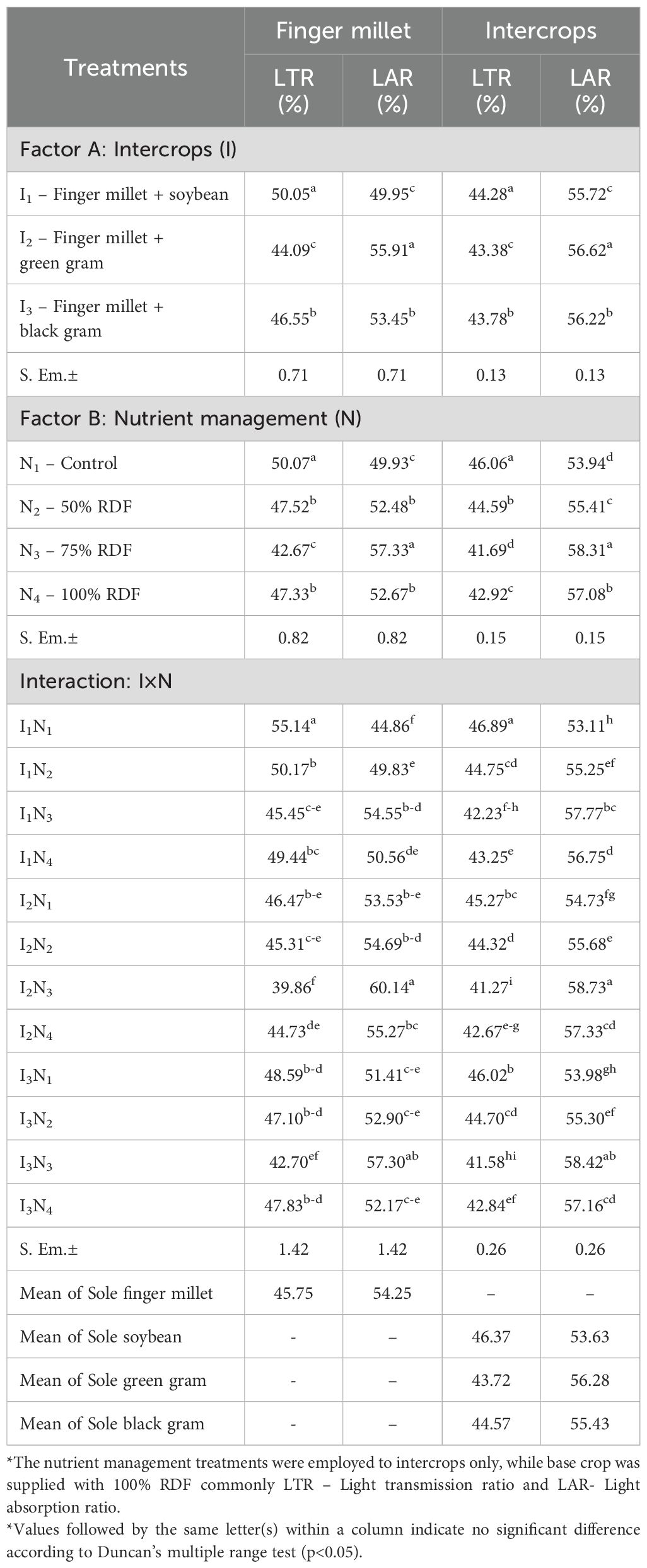
Table 2. Effect of intercropping and nutrient management on LTR and LAR of finger millet and intercrops in finger millet based cropping system.
Finger millet productivity varied significantly (p=0.05) due to both intercropping systems and nutrient management practices. Finger millet + green gram system recorded the highest grain yield (2513.10 kg/ha) and straw yield (7526.19 kg/ha), underscoring its effectiveness in enhancing biomass and economic yield components of the base crop. With respect to nutrient management, the application of 75% RDF to the component crop resulted in significantly (p=0.05) higher yield of finger millet (2688.98 kg grain/ha and 7850.88 kg straw/ha). Notably, the interaction between intercropping and nutrient management exerted a statistically significant (p=0.05) effect. The finger millet + green gram system, when coupled with 100% RDF to the base crop and 75% RDF to the component crop, yielded the highest grain yield (3372.5 kg/ha) and straw yield (9245 kg/ha). This superior performance may be attributed to the enhanced resource complementarity and minimized interspecific competition achieved through optimized spatial and temporal niche differentiation (Paramesh et al., 2025). The staggered phenological development wherein green gram completes its reproductive phase while finger millet remains in its vegetative stage likely reduced competition for critical resources during peak demand periods (Sannagoudar et al., 2023). Furthermore, the application of 75% RDF to the component crop appeared to reduce nutrient competition, allowing for more efficient nutrient uptake by finger millet and legume intercropping systems can enhance nitrogen use efficiency in cereals by facilitating partial transfer of biologically fixed nitrogen and improving below-ground mutualism. Efficient light interception, improved root-zone activity, and better moisture utilization under these systems also contribute to higher yield realization (Baradwal et al., 2022; Sharmili et al., 2023; Rundan et al., 2023). While 100% RDF given to component crop does not yield much because of nutrient antagonisim, imbalanced nutrient uptake which stress finger millet for translocation of nutrients to grain (Fageria et al., 2011). Overall, the results indicate that strategic integration of green gram as a component intercrop with judicious nutrient application (75% RDF) not only sustains but significantly (p=0.05) enhances yield performance in finger millet-based cropping systems, offering a viable approach for resource-efficient intensification and illustrated in Table 3.
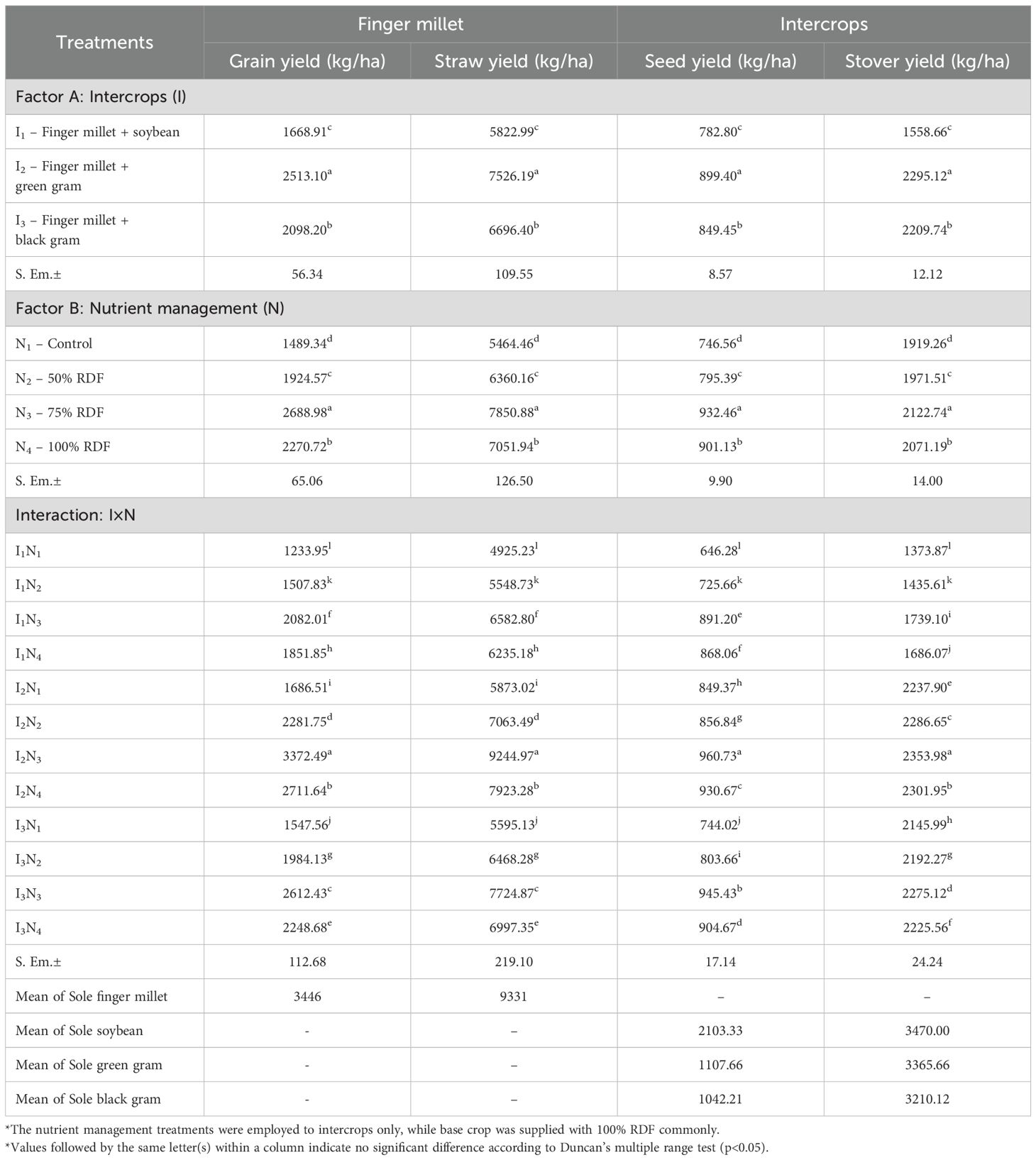
Table 3. Effect of intercropping and nutrient management on yield parameters of finger millet and intercrops in finger millet based cropping system.
Influence of intercropping and nutrient management on the growth and yield of component crops
The growth attributes of green gram were significantly influenced by both intercropping systems and nutrient management practices and exhibited in Table 4 and Table 2. In intercropping, the finger millet + green gram system recorded the highest values for number of branches per plant (18.16), dry matter accumulation (28.48 g/plant), absolute growth rate (AGR) (2.601 g/day), and crop growth rate (CGR) (86.68 g/m2/day). The maximum leaf area ratio (LAR) (56.62%) was also observed in green gram under this system. However, the highest leaf transmission ratio (LTR) (44.28%) was recorded in finger millet + soybean. These improvements in green gram performance can be attributed to enhanced spatial efficiency, improved light interception, and reduced intra-specific competition, resulting from the complementary interaction with finger millet (Tripathi and Kushwaha, 2013). Nutrient management had a pronounced effect on green gram growth. The application of 75% RDF to the component crop significantly (p=0.05) improved growth parameters, including number of branches per plant (17.62), dry matter accumulation (27.78 g/plant), AGR (1.717 g/day) and CGR (57.24 g/m2/day). Notably, the highest LAR (58.31%) was also recorded under this treatment, while LTR peaked (46.06%) in the absence of RDF application. These findings suggest that partial RDF application to the legume crop supports a more balanced distribution of resources between the intercrops, promoting better canopy development and physiological efficiency (Zaman and Malik, 2000). Interaction effects on green gram growth attributes, however, were statistically non-significant (p=0.05).
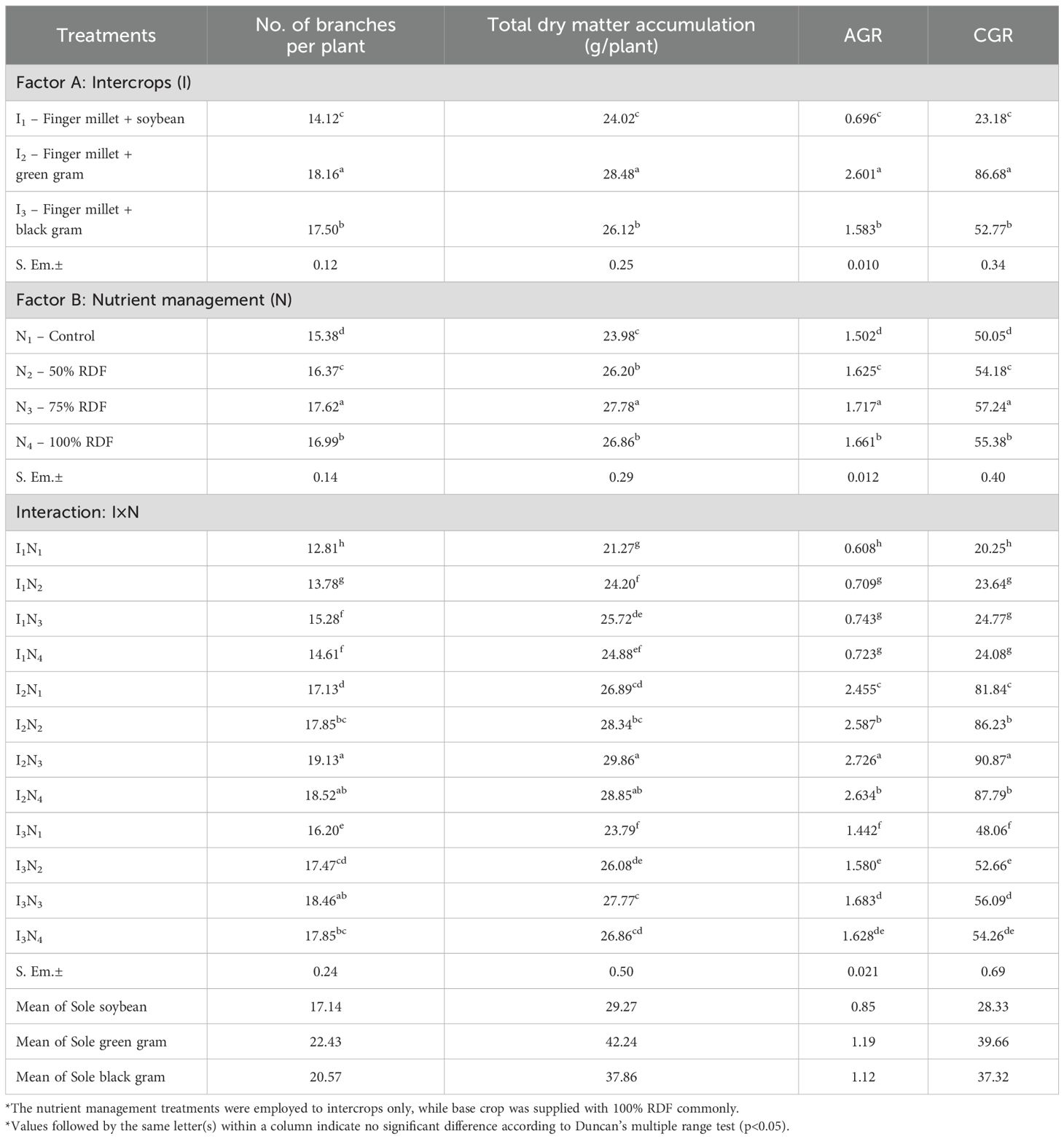
Table 4. Effect of intercropping and nutrient management on intercrops in finger millet based cropping system.
The productivity of green gram was significantly (p=0.05) influenced by both intercropping systems and nutrient management (Table 3). The finger millet + green gram treatment recorded the highest seed yield (899.40 kg/ha) and haulm yield (2295.12 kg/ha). This improved performance is likely due to green gram early phenological maturity, which minimizes competition with finger millet during critical growth periods (Rathore and Gautam, 2003). With conjunction of nutrient management, application of 100% RDF to the base crop combined with 75% RDF to the component crop resulted in the highest seed (932.46 kg/ha) and stover yield (2122.74 kg/ha) of green gram. This response may be attributed to the optimized nutrient environment, supporting robust vegetative and reproductive development without inducing luxury consumption or excessive vegetative growth common outcomes of 100% RDF in legumes (Praveen et al., 2023; Biswas et al., 2020). The interaction effects on yield were also significant. The combination of finger millet + green gram intercropping, with 100% RDF applied to the base crop and 75% RDF to green gram, yielded the highest seed (960.0 kg/ha) and haulm yield (2354.0 kg/ha). The temporal separation of peak nutrient demands, where green gram completes its reproductive phase while finger millet remains vegetative appears to reduce competition for nutrients, thereby enhancing yield efficiency (Sannagoudar et al., 2024). Furthermore, the moderate fertilization regime likely facilitated better nodulation and nitrogen fixation in green gram, contributing indirectly to system productivity. These results affirm that finger millet + green gram intercropping, complemented with 75% RDF to the component crop, presents a biologically efficient and resource-conserving strategy for maximizing both cereal and legume yields in intercropping systems.
Impact of intercropping and nutrient management on the growth and yield of sequence cowpea crop
The growth and yield performance of cowpea was significantly (p=0.05) influenced by the preceding intercropping system and nutrient management practices and depicted in Table 5. The finger millet + soybean – cowpea cropping system, with 100% RDF applied to the base crop (finger millet) and 75% RDF to the component crop (soybean), recorded the most favorable growth metrics in cowpea. This treatment produced the highest number of branches per plant (30.23), dry matter accumulation (24.93 g/plant), absolute growth rate (AGR) (0.74 g/day), and crop growth rate (CGR) (24.66 g/m²/day), and was statistically on par with the treatment receiving 100% RDF to both base and component crops because of enhanced growth parameters in cowpea may be attributed to the dual agronomic role of soybean within the intercropping system. Soybean functioned both as a nutrient accumulator and organic matter contributor, thereby enriching the rhizosphere with biologically fixed nitrogen, enhancing nutrient cycling from deeper soil layers, and improving soil structure (Biradar et al., 2023; Ghosh et al., 2020). Furthermore, the residual fertility effects and balanced nutrient dynamics from the preceding crop particularly under the 75% RDF regime likely created a favorable soil environment for the establishment and development of cowpea (Ghosh et al., 2021) and also legumes like soybean significantly improve subsequent crop performance through positive legacy effects on soil fertility and structure (Chandel et al., 2014; Hebbal et al., 2018; Krishna et al., 2020).
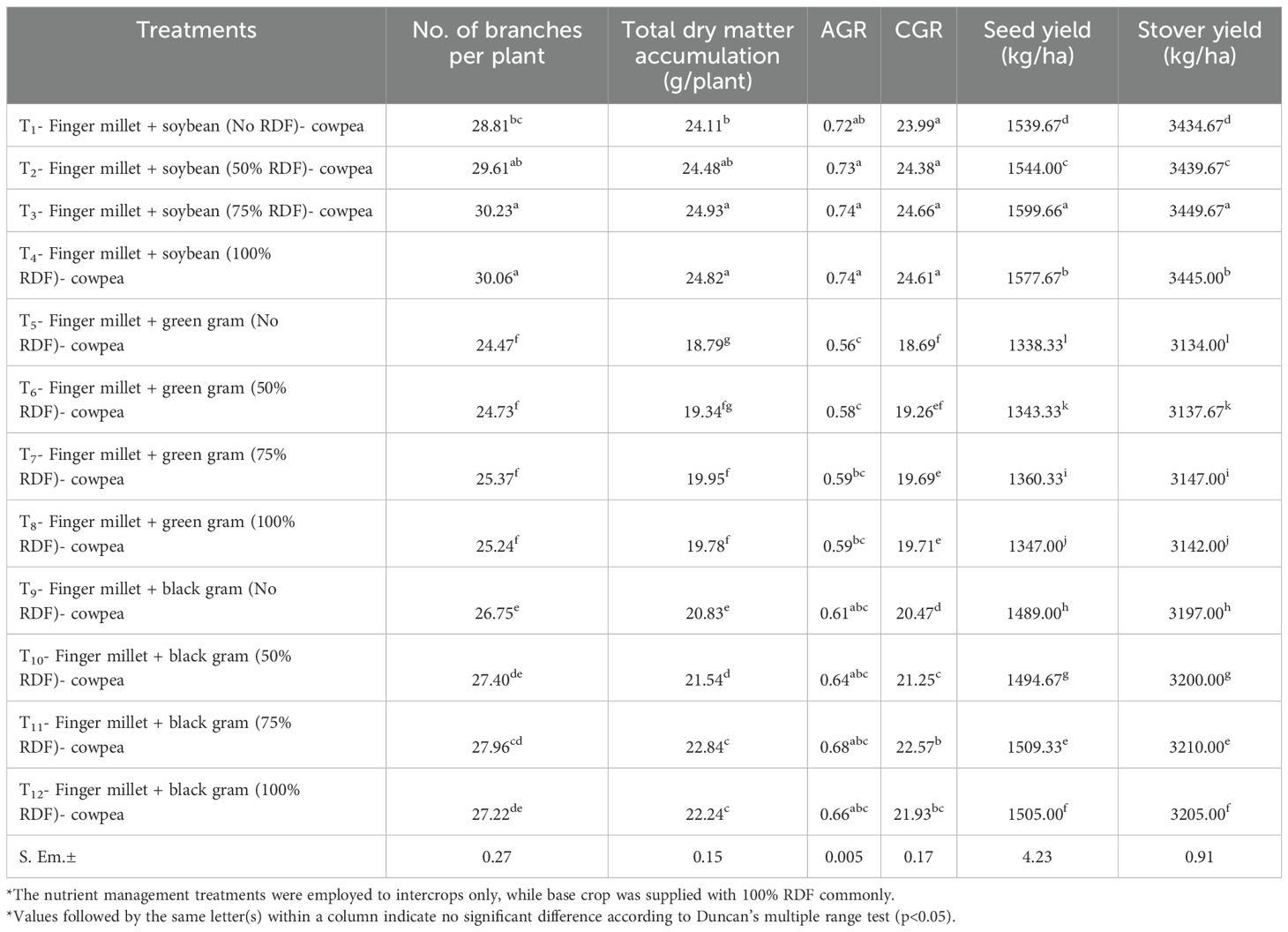
Table 5. Effect of intercropping and nutrient management on growth and yield parameters of sequence crop in finger millet based cropping system.
Cowpea seed and haulm yields were also significantly (p=0.05) influenced by the preceding cropping system and nutrient management strategies. The treatment involving finger millet + soybean with 100% RDF to the base crop and 75% RDF to soybean resulted in the highest seed yield (1599.66 kg/ha) and haulm yield (3449.67 kg/ha). This enhanced productivity may be attributed to the cumulative effects of residual nitrogen availability, reduced nutrient competition and improved soil physical conditions, facilitated by the symbiotic nitrogen fixation capacity of soybean. Notably, the application of 75% RDF to soybean appears to be a physiologically optimal level that supports robust vegetative and reproductive growth without inhibiting nodulation and nitrogen fixation, a phenomenon sometimes observed under full (100%) nitrogen application (Rajanna et al., 2023). This moderate fertilization supports both plant performance and soil enrichment, creating a synergistic effect that benefits the following cowpea crop (Niringye et al., 2005; Chandel et al., 2014). The findings underscore the role of strategically managed legume-based intercropping systems in enhancing system sustainability and productivity through improved nutrient use efficiency and soil resource legacy effects.
Impact of intercropping and nutrient management on available soil nutrient status after harvest of the crop
The analysis of the available N, P2O5 and K2O levels in the soil after harvest of crops, as affected by different intercrops and nutrient management, is presented in the Table 6 and Table 7.
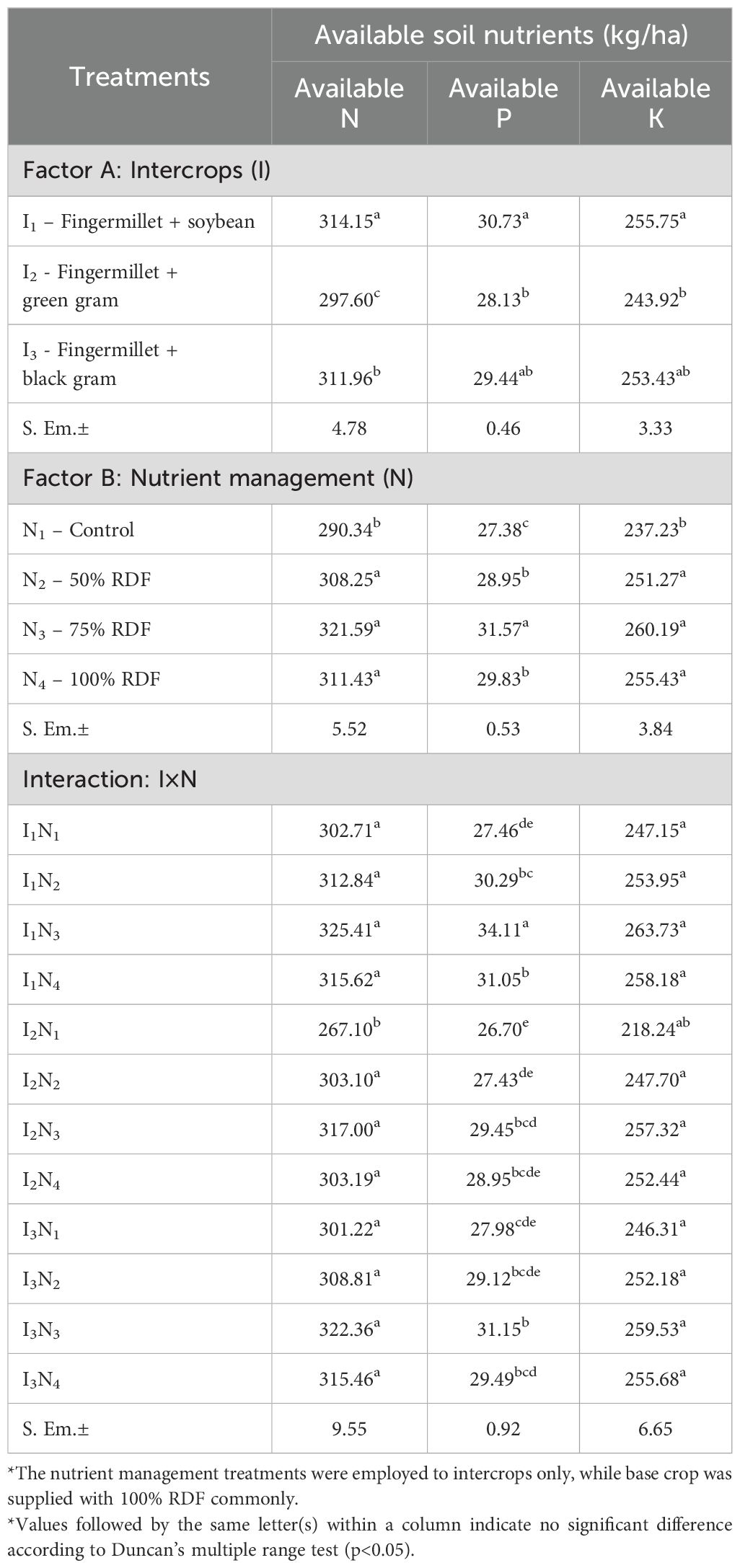
Table 6. Available soil nutrient status after harvest of crop in finger millet based cropping system.
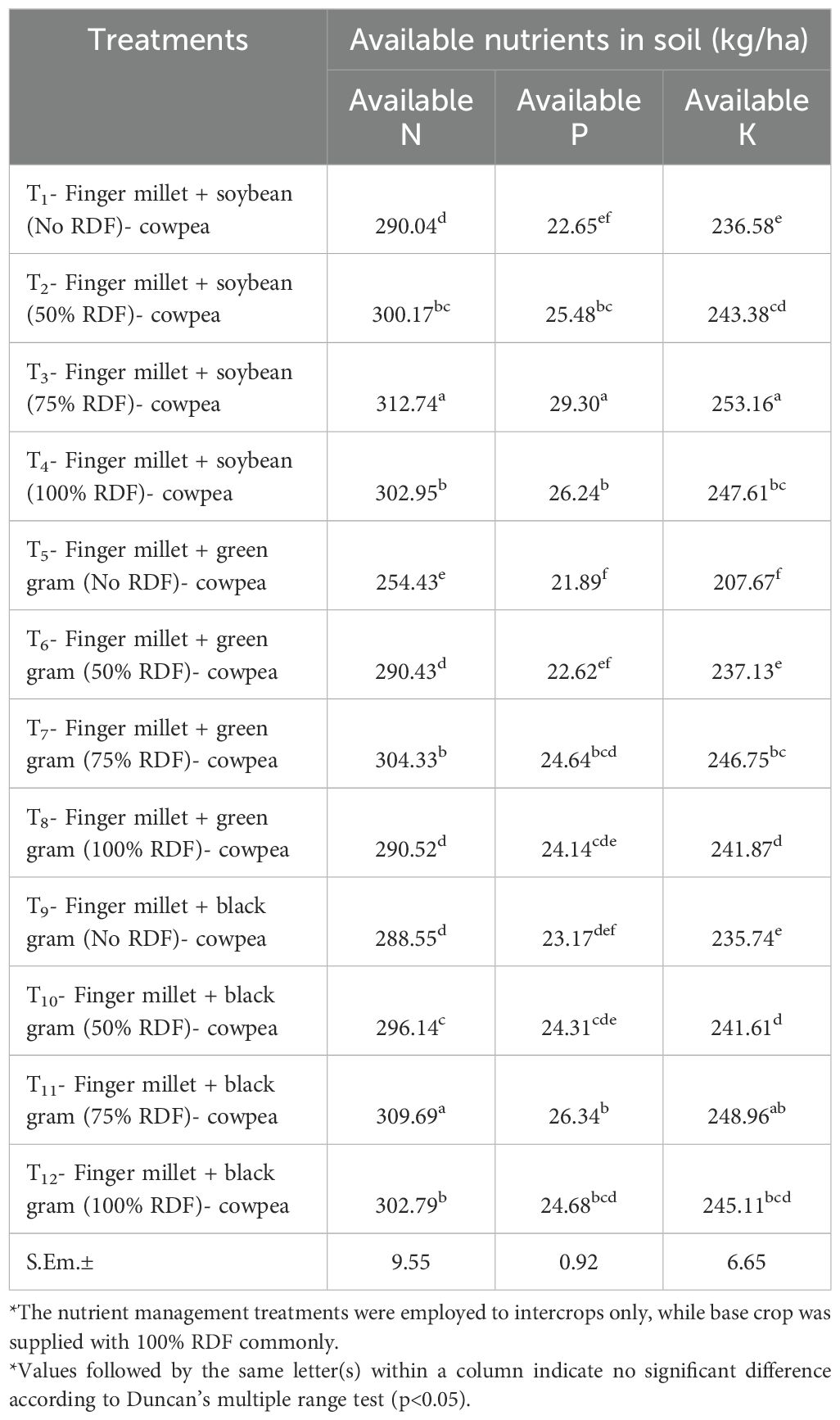
Table 7. Available soil nutrient status after harvest of crop in fingermillet based cropping system.
Post-harvest soil nutrient status was significantly influenced by both intercropping systems and nutrient management strategies. The finger millet + soybean intercropping system exhibited the highest levels (p=0.05) of available nitrogen (314.15 kg/ha), phosphorus (30.73 kg/ha), and potassium (255.75 kg/ha). This improvement is primarily attributed to the integration of legumes, which are known to contribute biologically fixed nitrogen to the soil, thereby enhancing nutrient availability for the associated non-leguminous crop (Sannagoudar et al., 2020; Baradwal et al., 2023). Beyond nitrogen enrichment, the legume component stimulated rhizosphere microbial activity, promoting the decomposition of organic matter and accelerating the mineralization of key nutrients (Ghosh et al., 2020). The distinct and complementary root architectures of finger millet and soybean likely enhanced vertical and horizontal nutrient foraging, leading to reduced interspecific competition and more effective nutrient uptake (Rakesh et al., 2022). Furthermore, the addition of legume biomass enriched soil organic matter, improved soil structure and contributed to enhanced nutrient retention capacity (Ghosh et al., 2021; Hongal, 2001; Nooli, 2001). Legume crops owe the potential to fix atmospheric nitrogen and also add huge quantity of plant biomass having low C:N ratio to soil, which decompose faster than other crop residue adding lots of nutrients to soil. These peculiar characters of legume help in reduced application of synthetic fertilizers which ensure soil health restoration, reduced impact of nutrient pollution in soil environment and ultimately pave way for sustainable and eco-friendly production systems. And with an application of 75% RDF to the component crop (alongside full RDF to the base crop) resulted in significantly (p=0.05) higher soil nutrient levels post-harvest: N (321.59 kg/ha), P2O5 (31.57 kg/ha) and K2O (260.19 kg/ha). This fertilization regime likely provided a balanced nutrient supply, sufficient to meet crop demands while avoiding excessive application that can lead to nutrient leaching or luxury consumption (Rathore and Gautam, 2003; Pandey et al., 2003). Moderate fertilization also supported enhanced microbial activity and root growth, promoting improved nutrient cycling and overall soil health (Ananthi et al., 2017; Ashish et al., 2015).
Following the harvest of the sequence crop (cowpea), the treatment finger millet + soybean (75% RDF) - cowpea maintained the highest residual soil nutrient levels (N: 312.74 kg/ha, P2O5: 29.30 kg/ha, K2O: 253.16 kg/ha). The presence of two leguminous crops in the system, soybean and cowpea likely contributed to sustained nitrogen enrichment through biological fixation by Rhizobium species, even under reduced external fertilizer inputs (Kamble and Kathmale, 2015). This system demonstrated the potential of integrated nutrient management and legume-based intercropping for improving soil fertility, reducing external input dependency and supporting sustainable intensification.
Impact of intercropping and nutrient management on cropping system indices
System productivity indices, including land equivalent ratio (LER), area time equivalent ratio (ATER), finger millet equivalent yield (FMEY) and competition ratio (CR), were significantly (p=0.05) influenced by both intercropping combinations and nutrient management strategies and represented in Table 8.
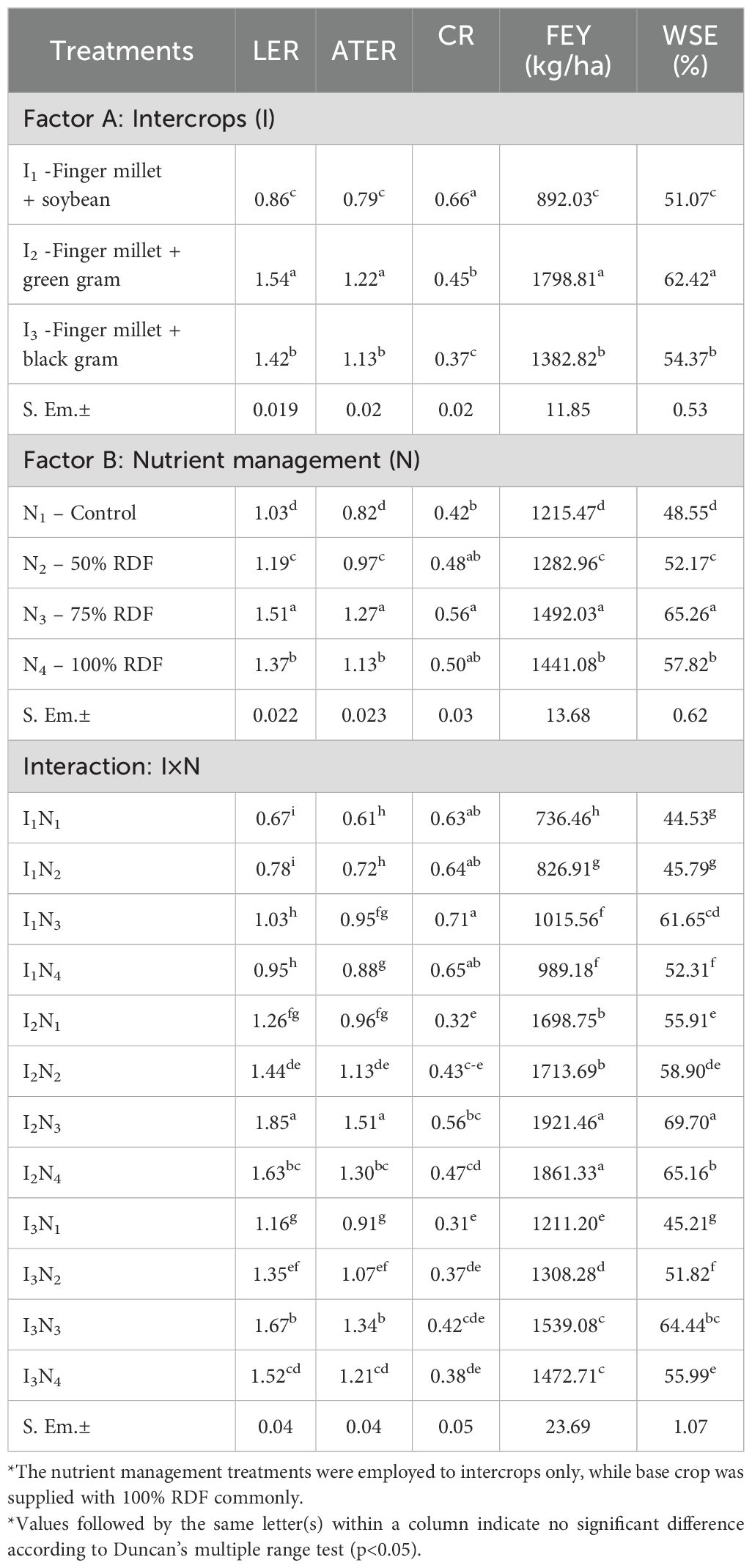
Table 8. Effect of intercropping and nutrient management on cropping system indices and weed smothering efficiency.
The highest LER (1.54) was recorded under the finger millet + green gram intercropping system. This advantage is attributed to the temporal complementarity between the two crops green gram, being a short-duration legume, matures earlier and thus reduces competitive pressure on finger millet during its critical growth stages. This synergistic relationship enhances the resource-use efficiency and biomass partitioning, ultimately improving system productivity compared to sole cropping (Choudhary, 2009). The inclusion of green gram also improves soil fertility through nitrogen fixation, indirectly benefiting finger millet. The application of 75% RDF to the component crop recorded a higher LER (1.51) due to the balanced temporal and spatial resource utilization, where early nutrient uptake by green gram was followed by sustained growth of finger millet, minimizing interspecific competition and maximizing complementary effects (Hamzei and Seyedi, 2015).
Similarly, the highest ATER (1.22) was also observed in the finger millet + green gram system. This index reflects the effective utilization of the available growing period, where in green gram captured early-season light, water and nutrients, while finger millet exploited these resources in the later stages, promoting staggered resource use and minimizing intra-seasonal competition (Kheroar and Patra, 2013). Nutrient-wise, ATER was maximized (1.27) with 75% RDF to the component crop, likely due to enhanced nodulation, nitrogen fixation and reduced overgrowth competition from green gram (Chhetri and Sinha, 2020).
In terms of economic productivity, the finger millet + green gram system achieved the highest finger millet equivalent yield (FMEY) of 1798.81 kg/ha. This increase is primarily due to the substantial contribution of green gram, which, despite its shorter duration, produced an appreciable economic yield. The yield from green gram, when converted to finger millet equivalent using prevailing market prices, significantly (p=0.05) boosted total productivity (Thavaprakaash et al., 2005; Victor et al., 2023). The application of 75% RDF to the component crop performed the highest FMEY (1492.03 kg/ha), indicating optimal nutrient synergy that supported efficient photosynthesis, nodulation and nitrogen transfer from green gram to finger millet (Tripathi and Kushwaha, 2013; Singh et al., 2016; Rundan et al., 2023).
In contrast, competition ratio (CR), which quantifies the degree of interspecific competition, was highest (0.66) under the finger millet + soybean system. This suggests that soybean exerted stronger competitive pressure on finger millet due to its aggressive vegetative growth, expansive canopy, and higher nutrient and water demands particularly during overlapping growth stages (Ghosh, 2004; Sharmili et al., 2023) and with an application of 75% RDF to the component crop further increased CR (0.56), indicating that enhanced nutrient availability intensified soybean’s dominance in resource capture (Chhetri and Sinha, 2020).
Notably, the interaction effects between intercropping systems and nutrient management treatments on these indices were statistically non-significant (p=0.05), indicating consistent patterns across systems.
Impact of intercropping and nutrient management on weed smothering efficiency
The finger millet + green gram intercropping system recorded the highest weed smothering efficiency (WSE) at 73.46%, significantly (p=0.05) outperforming other intercropping combinations. This enhancement is attributed to reduced weed biomass and density, likely due to intensified interspecific competition and complementary interactions between component crops, which improved the crop stand suppressive ability against weeds (Hauggaard-Nielsen et al., 2003; Sannagoudar et al., 2024). Under nutrient management practices, the application of 75% RDF to the component crop resulted in the maximum WSE (76.14%). This outcome is primarily driven by the shading effect and competitive pressure from the well-developed green gram canopy, which limited light availability and physical space for weed growth (Sannagoudar et al., 2021; Halli et al., 2021). The dense foliage created a microenvironment unfavorable for weed establishment, thereby narrowing the ecological niche for weed proliferation (Pandey et al., 2003). However, interaction effects between cropping system and nutrient management on WSE were statistically non-significant.
Conclusion
The intercropping system of finger millet + green gram, combined with 75% RDF applied to the component crop, significantly (p=0.05) enhanced growth parameters, yield attributes, and cropping system indices compared to other treatments. This can be attributed to the complementary growth habits of the component crops, where finger millet and green gram utilizes soil nutrients, water, and light more efficiently, minimizing competition and enhancing overall resource use. Moreover, green gram, being a leguminous crop, contributes to biological nitrogen fixation (BNF), enriching the soil nitrogen pool and reducing the dependence on synthetic nitrogen fertilizers. Furthermore, in the sequence cropping system, sole soybean followed by cowpea exhibited superior growth performance. This improved performance may be due to the nitrogen-fixing ability of soybean, which enriches the soil and creates a favorable environment for the subsequent crop (cowpea), thereby enhancing its growth parameters. Across nutrient management strategies, application of 75% RDF to the component crop consistently resulted in improved outcomes, underscoring the effectiveness of optimized nutrient allocation in finger millet-based cropping systems. This suggests that lower but targeted nutrient application improves nutrient-use efficiency, reduces environmental losses, and still provides adequate nourishment to sustain high productivity.
Data availability statement
The original contributions presented in the study are included in the article/supplementary material. Further inquiries can be directed to the corresponding authors.
Author contributions
S: Investigation, Writing – original draft, Writing – review & editing, Conceptualization. BL: Conceptualization, Writing – original draft, Writing – review & editing, Methodology. KM: Project administration, Conceptualization, Methodology, Writing – review & editing, Writing – original draft, Supervision. MS: Methodology, Writing – review & editing, Validation, Writing – original draft, Formal analysis, Funding acquisition. KN: Validation, Writing – review & editing, Formal analysis, Resources. CK: Validation, Methodology, Conceptualization, Writing – original draft. SH: Data curation, Methodology, Investigation, Writing – original draft, Conceptualization. HT: Methodology, Conceptualization, Investigation, Writing – original draft. MN: Data curation, Funding acquisition, Conceptualization, Writing – review & editing, Formal analysis. RS: Writing – review & editing, Resources, Methodology, Project administration, Investigation. HJ: Conceptualization, Supervision, Writing – review & editing. TA: Writing – review & editing. RV: Conceptualization, Supervision, Writing – review & editing. GR: Conceptualization, Writing – review & editing.
Funding
The author(s) declare that no financial support was received for the research and/or publication of this article.
Acknowledgments
The authors express their gratitude to the University of Agricultural Sciences, Bangalore, Karnataka, India, for granting access to the necessary facilities to carry out the experiments.
Conflict of interest
The authors declare that the research was conducted in the absence of any commercial or financial relationships that could be construed as a potential conflict of interest.
Generative AI statement
The author(s) declare that no Generative AI was used in the creation of this manuscript.
Any alternative text (alt text) provided alongside figures in this article has been generated by Frontiers with the support of artificial intelligence and reasonable efforts have been made to ensure accuracy, including review by the authors wherever possible. If you identify any issues, please contact us.
Publisher’s note
All claims expressed in this article are solely those of the authors and do not necessarily represent those of their affiliated organizations, or those of the publisher, the editors and the reviewers. Any product that may be evaluated in this article, or claim that may be made by its manufacturer, is not guaranteed or endorsed by the publisher.
References
Ahmed M., Asim M., Ahmad S., and Aslam M. (2022). Climate Change, Agricultural Productivity, and Food Security in Global Agricultural Production: Resilience to Climate Change (Switzerland: Springer International Publishing), 31–72.
Akchaya K., Parasuraman P., Pandian K., Vijayakumar S., Thirukumaran K., Mustaffa M. R. A. F., et al. (2025). Boosting resource use efficiency, soil fertility, food security, ecosystem services, and climate resilience with legume intercropping: a review. Front. Sustain. Food. Syst. 9, 152–174. doi: 10.3389/fsufs.2025.1527256
Ananthi T., Amanullah M., Abdel R. M., and Tawaha (2017). A Review on Maize - legume intercropping for enhancing the productivity and soil fertility for sustainable agriculture in India. Adv. Environ. Biol. 11, 49–63.
Anonymous (2023). Agricultural Statistics at a Glance; Directorate of Economics and Statistics (New Delhi, India: Government of India).
Ashish D., Singh A., Naresh R. K., Tomar S. S., Singh R. V., and And Darvin P. (2015). Response of maize + mash bean intercropping system to planting geometry and nutrient management in NWP zone of India. J. Pro. Agric. 6, 125–128.
Baradwal H., Ghosh A., Kumar A., Singh P. D., Sannagoudar M. S., Ahamad S., et al. (2022). Ecological restoration of degraded lands with alternate land use systems improves soil functionality in semiarid tropical India. Land Degradation Dev. 33, 1076–1087. doi: 10.1002/ldr.4225
Baradwal H., Ghosh A., Singh A. K., Jiménez-Ballesta R., Yadav R. K., Misra S., et al. (2023). Soil nutrient dynamics under silviculture, silvipasture and hortipasture as alternate land-use systems in semi-arid environment. Forests. 14, 125. doi: 10.3390/f14010125
Belete T. and Yadete E. (2023). Effect of mono cropping on soil health and fertility Management for Sustainable Agriculture Practices: a review. J. Plant Sci. 11, 192–197. doi: 10.11648/j.jps.20231106.13
Biradar B., Jayadev H. M., Halli H. M., and Sannagoudar M. S. (2023). Mapping of soil test-based spatial fertilizer recommendations for paddy and maize using GIS, GPS and STCR approaches in a micro-watershed of Karnataka, India. Curr. Science. 124, 113891. doi: 10.18520/cs/v124/i10/1160-1166
Biswas S., Jana K., Agrawal R. K., and Puste A. M. (2020). Effect of integrated nutrient management on green forage, dry matter and crude protein yield of oat in oat-Lathyrus intercropping system. J. Crop Weed. 16, 233–238. doi: 10.22271/09746315.2020.v16.i2.1342
Chamkhi I., Cheto S., Geistlinger J., Zeroual Y., Kouisni L., Bargaz A., et al. (2022). Legume-based intercropping systems promote beneficial rhizobacterial community and crop yield under stressing conditions. Ind. Crops Prod. 183, 114958. doi: 10.1016/j.indcrop.2022.114958
Chandel B. S., Singh S., Singh H., and Singh V. (2014). Direct and residual effect of nutrient management in wheat–maize cropping sequence. J. Indian. Soc Soil. Sci. 62, 126–130.
Chavan I. B., Jagtap D. N., and Mahadkar U. V. (2017). Weed control efficiency and yield of finger millet [Eleusine coracana (L.) Gaertn.] influenced due to different establishment techniques, levels and time of application of nitrogen. Farm. Manage. 2, 108–113. doi: 10.5958/2456-8724.2017.00014.5
Chhetri B. and Sinha A. C. (2020). Advantage of maize (Zea mays)-based intercropping system to different nutrient management practices. Indian. J. Agron. 65, 25–32.
Choudhary R. A. (2009). Intercropping in pearl millet (Pennisetum glaucum L.) with pluse crops in rainfed conditions. Sardar krushinagar Dantiwada Agricultural University, Sardarkrushinagar.
Choudhary V. K., Dixit A., SureshKumar P., and Chauhan B. S. (2014). Productivity, weed dynamics, nutrient mining and monetary advantage of maize-legume intercropping in the Eastern Himalayan Region of India. Plant Prod. Sci. 17, 342–352.
Dass A., Venkatesh P., Choudhary A. K., Upadhyay P. K., Chandrashekar A. B., Francaviglia R., et al. (2024). Soil moisture dynamics, rooting traits, crop and water productivity of wheat under different tillage, irrigation and nutrition conditions. Farming System. 2, 100087. doi: 10.1016/j.farsys.2024.100087
Dong H., Lin J., Lu J., Li L., Yu Z., Kumar A., et al. (2024). Priming effects of surface soil organic carbon decreased with warming: a global meta-analysis. Plant Soil. 500, 233–242. doi: 10.1007/s11104-022-05851-1
Fageria N. K., Baligar V. C., and Li Y. C. (2011). The role of nutrient efficient plants in improving crop yields in the twenty first century. J. Plant Nutr. 34, 911–922.
Falcon W. P., Naylor R. L., and Shankar N. D. (2022). Rethinking global food demand for 2050. Popul. Dev. Rev. 48, 921–957. doi: 10.1111/padr.12508
Ghosh A., Singh A. K., Kumar S., Manna M. C., Bhattacharyya R., Agnihortri R., et al. (2020). Differentiating biological and chemical factors of top and deep soil carbon sequestration in semi-arid tropical Inceptisol: an outcome of structural equation modeling. Carbon Management. 11, 441–453. doi: 10.1080/17583004.2020.1796143
Ghosh A., Singh A. K., Kumar S., Manna M. C., Jha P., Bhattacharyya R., et al. (2021). Do moisture conservation practices influence stability of soil organic carbon and structure. Catena. 199, 105127. doi: 10.1016/j.catena.2020.105127
Ghosh P. K. (2004). Growth, yield, competition and economics of groundnut/cereal fodder intercropping systems in the semi-arid tropics of India. Field. Crops. Res. 88, 227–237. doi: 10.1016/j.fcr.2004.01.015
Gopalan C., Ramashastri B. V., and Balasubramanium S. C. (2002). Nutritive value of Indian foods (Hyderabad: National Institute of Nutrition, ICMR).
Gull A., Jan R., Nayik G. A., Prasad K., and Kumar P. (2014). Significance of finger millet in nutrition, health and value-added products: a review. J. Envt. Sci. Comp. Sci. Eng. Tech. 3, 1601–1608.
Gupta G., Dhar S., Dass A., Sharma V. K., Shukla L., Singh R., et al. (2020). Assessment of bio-inoculants-mediated nutrient management in terms of productivity, profitability and nutrient harvest index of pigeon pea–wheat cropping system in India. J. Plant Nutr. 43, 2911–2928. doi: 10.1080/01904167.2020.1806302
Gupta G., Dhar S., Kumar A., Choudhary A. K., Dass A., Sharma V. K., et al. (2022). Microbes-mediated integrated nutrient management for improved rhizo-modulation, pigeonpea productivity, and soil bio-fertility in a semi-arid agro-ecology. Front. Microbiol. 13, 924407. doi: 10.3389/fmicb.2022.924407
Halli H. M., Angadi S., Govindasamy P., Madar R., Sannagoudar M. S., El-Sabrout A. M., et al. (2021). Integrated effect of deficit irrigation and sowing methods on weed dynamics and system productivity of maize–cowpea sequence on vertisols. Agronomy. 11, 808. doi: 10.3390/agronomy11040808
Hamzei J. and Seyedi M. (2015). Evaluation of the effects of intercropping systems on yield performance, land equivalent ratio and weed control efficiency. Agric. Res. 4, 202–207. doi: 10.1007/s40003-015-0161-y
Hauggaard-Nielsen H., Jornsgaard B., and Steen J. E. (2003). “Legume-cereal intercropping system as a weed management tool,” in Proceedings of the 4thEur. Weed Res. Soc. Workshop: Crop weed competition interaction (Universita Tusca, Viterbro, Italy). 10-12th April.
Hayat R., Ali S., Amara U., Khalid R., and Ahmed I. (2010). Soil beneficial bacteria and their role in plant growth promotion: A review. Ann. Microbiol. 60, 579–598. doi: 10.1007/s13213-010-0117-1
Hebbal N., Ramachandrappa B. K., Mudalairiyappa, and Thimmegouda M. N. (2018). Yield and economics of finger millet with establishment methods under different planting geometry and nutrient source. Indian. J. Agric. Res. 33, 54–58. doi: 10.5958/2231-6701.2018.00010.6
Hiebsch C. K. and Macollam R. E. (1980). Area time equivalent ratio. A method of evaluating productivity of intercrops. Agron. J. 75, 15–22.
Hongal M. M. (2001). Effect of green manuring and level of nitrogen on the performances of chilli +cotton intercropping system. Uni. Agril. Sci., Dharwad.
Jan R., Saxena A., and Khanday M. (2016). Intercropping indices and yield attributes of maize and black cowpea under various planting patterns. Bioscan. 11, 1–5.
Kamble B. M. and Kathmale D. K. (2015). Effect of different levels of customized fertilizer on soil nutrient availability, yield and economics of onion. J. Appl. Nat. Sci. 7, 817–821. doi: 10.31018/jans.v7i2.688
Kaushik S. S. and Sharma T. D. (2017). Wheat and component intercrop yield, land equivalent ratio and monetary indices influenced by intercropping and row proportions. Int. J. Curr. Microbiol. Appl. Sci. 6, 2626–2631. doi: 10.20546/ijcmas.2017.607.370
Kheroar S. and Patra B. C. (2013). Advantages of maize-legume intercropping systems. J. Agric. Sci. Technol. 3, 733–744.
Krishna K. V., Deepthi C. H., Reddy M. D., Raju P. S., and Pal A. (2020). Effect of nitrogen and phosphorus levels on growth and yield of finger millet [Eleusine coracana (L.)] during summer. Indian J. Agric. Res. 54, 227–231.
Kumar A., Kumar V., Thakur M., Singh K., Jasrotia R., Kumar R., et al. (2025). Global perspectives on lead contamination and health risks in surface water, rice grains, and soils. Land Degrad. Dev. 36, 2159–2169. doi: 10.1002/ldr.5510
Kumar A., Mishra S., Bakshi S., Upadhyay P., and Thakur T. (2022). Response of eutrophication and water quality drivers on greenhouse gas emissions in lakes of China: A critical analysis. Ecohydrol. 16, e2483. doi: 10.1002/eco.2483
Maitra S. and Ray D. P. (2019). Enrichment of biodiversity, influence on Microbial population dynamics of soil and nutrient utilization in cereal-legume intercropping Systems: A Review. Int. J. Bioresour. Sci. 6, 11–19. doi: 10.30954/2347-9655.01.2019.3
Mohan Kumar R., Yamanura, and Boraiah B. (2022). Bio-irrigation: A drought alleviation strategy through induced hydro-parasitization under bi-cropping practices of rainfed agro-ecosystem: A review. Agric. Rev. 43, 211–216. doi: 10.18805/ag.R-2139
Mrabet R. (2023). Sustainable Agriculture for Food and Nutritional Security In Sustainable Agriculture and the Environment (London: Academic Press), 25–90.
Niringye C. S., Ssekabembe C. S., and Kayamanywa S. (2005). Effect of plant nodulation on yield of maize and climbing beans grown in an intercropping system. Afr. Crop Sci. J. 13, 83–93.
Nooli S. S. (2001). Influences of in situ green manuring of intercropped legumes on the performances of maize-safflower sequence cropping. Uni. Agril. Sci., Dharwad.
Pandey I. B., Bharati V., and Mishra S. S. (2003). Effect of maize-based intercropping systems on maize yield and associated weeds under rainfed condition. India. J. Agron. 48, 30–33.
Panse V. G. and Sukhatme P. V. (1967). Statistical Methods For Agricultural Workers (New Delhi: ICAR Publications), 359.
Paramesh V., Kumar P., Kumar R. M., Jinger D., Chillarge S., Bhattacharjee S., et al. (2025). Soil quality enhancement in arecanut (Areca catechu)-based agroforestry system: Insights from organic farming and integrated nutrient management. Indian. J.Agric.Sci. 95, 331–335. doi: 10.56093/ijas.v95i3.162261
Patidar P., Sannagoudar M. S., Ghosh A., Singh A. K., Misra S., Khandibagur V., et al. (2023). Tropical range grasses can sustain soil functions despite nutrient depletion in semiarid degraded land. Front. Sustain. Food Syst. 7, 1230156. doi: 10.3389/fsufs.2023.1230156
Praveen B. R., Sannagoudar M. S., Babu R. C., Rajanna G. A., Singh M., Kumar S., et al. (2023). “Sustainable use of paddy straw as livestock feed: A climate resilient approach to crop residue burning,” in Molecular Interventions for Developing Climate-Smart Crops: A Forage Perspective (Springer Nature Singapore, Singapore), 197–214.
Radford D. J. (1967). Growth analysis - their use and abuse. Crop Sci. 7, 171–175. doi: 10.2135/cropsci1967.0011183X000700030001x
Rajanna G. A., Dass A., Singh V. K., Choudhary A. K., Paramesh V., Babu S., et al. (2023). Energy and carbon budgeting in a soybean–wheat system in different tillage, irrigation and fertilizer management practices in South-Asian semi-arid agroecology. Eur. J. Agron. 148, 126877. doi: 10.1016/j.eja.2023.126877
Rakesh S., Kamalakar J., Raju B., Jannu N., Pandit V. B., Kunta R., et al. (2022). Understanding carbon trading: accomplishments and prospects in India and other countries. Climate Change Environ. Sustainability. 10, 113–122.
Rathore S. S. and Gautam R. C. (2003). Agrotechniques to improve the productivity of pearlmillet + cowpea intercropping system under dryland conditions. Ann. Agric. Res. 24, 971–975.
Rundan V., Singh M., Praveen B. R., Yadav M. B. N., and Chethan B. R. (2023). Proximate composition assessment of fodder maize with ricebean intercropping under different nutrient management practices. Ann. Plant Soil Res. 25, 641–648.
Sachin K. S., Dass A., Dhar S., Rajanna G. A., Singh T., Sudhishri S., et al. (2023). Sensor-based precision nutrient and irrigation management enhances the physiological performance, water productivity, and yield of soybean under system of crop intensification. Front. Plant Sci. 14, 1282217. doi: 10.3389/fpls.2023.1282217
Sannagoudar M. S. and Murthy K. K. (2018). Growth and yield of maize (Zea mays L.) as influenced by planting geometry and nutrient management in maize-based intercropping. Mysore J. Agric. Sci. 52, 278–284.
Sannagoudar M. S., Murthy K. N., Ghosh A., Singh A. K., Gupta G., Halli H. M., et al. (2024). Comparative efficacy of leguminous intercrops and weed management practices on nutrient uptake, productivity and profitability of maize based intercropping system. Legume. Res. 47, 1549–1554.
Sannagoudar M. S., Murthy K. K., Nagaraju G. R., Ghosh A.V. I. J. I. T., Singh A. K., Gupta G. A. U. R. E. N. D. R. A., et al. (2021). Influence of weed management practices in maize (Zea mays) based intercropping system. Indian. J. Agric. Sci. 91, 1067–1071. doi: 10.56093/ijas.v91i7.115133
Sannagoudar M. S., Patil R. H., Kumar R. V., Singh A. K., Ghosh A., and Halli H. M. (2020). Simulated impacts of rise in temperature on kharif sorghum genotypes in Northern Transitional Zone of Karnataka, India. Cereal. Res. Commun. 48, 113–120. doi: 10.1007/s42976-020-00011-6
Sannagoudar M. S., Patil R. H., Rajanna G. A., Ghosh A., Singh A. K., Halli H. M., et al. (2023). Rising temperature coupled with reduced rainfall will adversely affect yield of kharif sorghum genotypes. Curr. Sci. 124, 921. doi: 10.18520/cs/v124/i8/921-927
Sharmili K., Parasuraman P., and Sivagamy K. (2023). Effect of inter and sequential cropping of pulses in little millet (Panicum sumatranse L.) based cropping system. Indian J. Agric. Res. 57, 52–55.
Shekara B. G., Mahadevu P., Chikkarugi N. M., Sannagoudar M. S., Manasa N., Rajanna G. A., et al. (2025). Maximizing forage yield and quality of grasses through strategic nutrient management in established coconut orchards. Indian. J. Agric. Sci. 95, 219–224. doi: 10.56093/ijas.v95i2.152417
Singh P., Singh K. M., and Shahi B. (2016). Pulses for sustainable livelihood and food security (Germany: Munich Personal RePEc Archive). Available at: https://mpra.ub.uni-muenchen.de/80269/ (Accessed May 10, 2025).
Subbiah B. V. and Asija G. L. (1956). A rapid procedure for the estimation of available nitrogen in Soil. Curr. Sci. 25, 259–260.
Sukanya T. S., Kumar A., Sathya K., Chaithra C., Narayanan A. L., Anand M. R., et al. (2023). Nutri cereals role in Indian agriculture, food and nutritional security: A Review. Mysore J. Agric. Sci. 57, 1–10.
Sukanya T. S., Sneha M. A., Chaithra C., and Ragimasalawada M. (2024). Optimizing productivity and resource use efficiency under a finger millet-based cropping system. Sustainability. 16, 1–17. doi: 10.3390/su162411046
Thavaprakaash N., Velayudham K., and Muthukumar V. B. (2005). Effect of crop geometry, intercropping systems and integrated nutrient management practices on productivity of baby corn (Zea mays L.) based intercropping systems. Res. J. Agric. Sci. 1, 295–302.
Tripathi A. K. and Kushwaha H. S. (2013). Performance of pearl millet (Pennisetum glaucum) intercropped with pigeonpea (Cajanus cajan) under varying fertility levels in the rainfed environment of Bundelkhand region. Ann. Agric. Res. 34, 36–43.
Victor V. P., Sharmili K., Kumar D. P., Minithra R., and Balaganesh B. (2023). Performance of pearl millet and pulses based intercropping system under rainfed condition. Int. J. Environ. Clim. Change. 13, 747–752. doi: 10.9734/ijecc/2023/v13i82006
Vijayakumari J., Mushtar B. J., Shamshad B., and Sumangala G. (2003). “Sensory attributes of ethnic foods from finger millet,” in Recent trends in millet processing and utilization (Paper presented at CCSHAU, Hisar), 7–12.
West C., Briggs G. E., and Kidd F. (1920). Methods and significant relation in a quantitative analysis of plant growth. New Phytol. 19, 200–207. doi: 10.1111/j.1469-8137.1920.tb07327.x
Willey R. W. (1979). Intercropping - its importance and research needs, Part-I, Competition and yield advantages. Field Crop Abstracts 32, 1–10.
Yoshida S., Forno D. D., Cock J. H., and Gomez K. A. (1972). Laboratory Manual for Physiological Studies of Rice (Manila, Philippines: International Rice Research Institute (IRRI), 67–88.
Keywords: finger millet equivalent yield, intercropping, land equivalent ratio, nutrient management, competition ratio, soil health, weed smothering efficiency
Citation: Shilpa, Lalitha BS, Nagaraj KH, Murthy KNK, Jayadeva HM, Sannagoudar MS, Vasundhara R, Amrutha TG, Nagangoudar MB, Raddy G, Salmankhan RM, Kavyashree C, Thimmaiah HP and Hosalli SB (2025) Crop diversification strategies for yield enhancement in finger millet-based cropping systems. Front. Agron. 7:1644473. doi: 10.3389/fagro.2025.1644473
Received: 10 June 2025; Accepted: 11 July 2025;
Published: 21 October 2025.
Edited by:
Dinesh Jinger, Indian Institute of Soil and Water Conservation (ICAR), IndiaReviewed by:
Amit Kumar, Nanjing University of Information Science and Technology, ChinaKamal Garg, Indian Agricultural Research Institute (ICAR), India
Rajendra Prasad Meena, ICAR-Vivekananda Parvatiya Krishi Anusandhan Sansthan, India
Copyright © 2025 Shilpa, Lalitha, Nagaraj, Murthy, Jayadeva, Sannagoudar, Vasundhara, Amrutha, Nagangoudar, Raddy, Salmankhan, Kavyashree, Thimmaiah and Hosalli. This is an open-access article distributed under the terms of the Creative Commons Attribution License (CC BY). The use, distribution or reproduction in other forums is permitted, provided the original author(s) and the copyright owner(s) are credited and that the original publication in this journal is cited, in accordance with accepted academic practice. No use, distribution or reproduction is permitted which does not comply with these terms.
*Correspondence: Manjanagouda S. Sannagoudar, bXNzYWdyb25AZ21haWwuY29t; Shilpa, c2hpbHBhaG9zbWFuaTE5OTlAZ21haWwuY29t
 Shilpa
Shilpa B. S. Lalitha1
B. S. Lalitha1 Mahantesh B. Nagangoudar
Mahantesh B. Nagangoudar